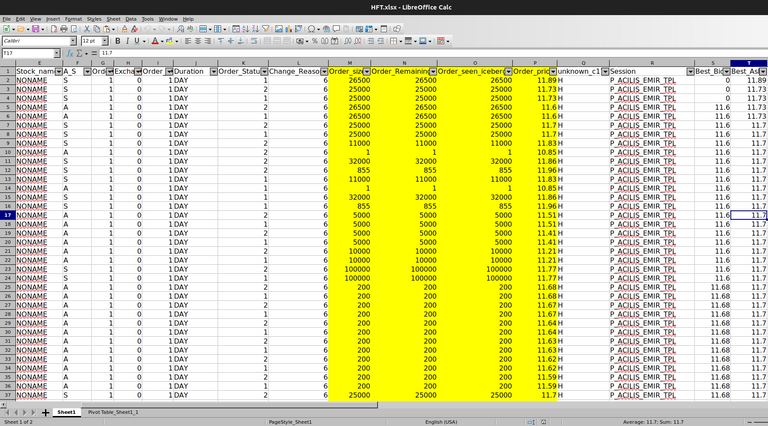I have previously reviewed some daily trading algorithms on this subject on Tradingview website. As I understand it, there are daily trading bots that have been modified or developed around these algorithms, along with some basic approaches. If we categorize these forecasting methods in general, we come across technical analysis, statistical models, fundamental analysis and sentiment analysis.
Today, I will step into HFT using limit order book.

It is important to note that stock price prediction is a challenging task and the accuracy of redictions can vary greatly depending on the method and data used. I think, combining multiple methods and considering other factors such as market conditions, economic indicators and company-specific news and events can improve the accuracy of the predictions.
According to the definition, high frequency trading (HFT) is a type of algorithmic trading that utilizes advanced computer algorithms and high-speed communication networks to execute trades at extremely high speeds and volumes. These algorithms are designed to identify market opportunities and execute trades based on certain conditions, such as price changes or order book imbalances, without human intervention. HFT is typically used by large financial firms and investment firms to make rapid trades in financial markets, such as stocks, bonds, and derivatives, in orderr to take advantage of small price movements and liquidity imbalances. It has become a popular form of trading due to its ability to quickly identify and exploit market inefficiencies, but it can also be associated with high risks, as the algorithms are complex and the speed of trades can lead to increased volatility.
Suppose you have 10000 USD, to invest on this stock for one day, you are allowed to short sell by the same amount. How would you invest your money?
Probably, I would first analyze the data to identify patterns and opportunities to invest my 10000 USD in the stock using HFT and the limit order book history. This would involve studying the order book, including the bid and ask prices and sizes, as well as any trends in the realized trades. The market depth chart can form an idea of where the buying-selling pressure is. I would create a market depth chart based on bid-ask prices for this. In addition, it is possible to get an idea of the price distributions with the help of the pivot table.
I would also use a complex algorithm to determine the optimal times to buy and sell the stock. This could include using statistical arbitrage techniques, such as co-integration, to identify misspricings in the market and profit from them. The algorithm could also use machine learning techniques, such s decision trees or neural networks, to predict future price changes. Setting a time limit for my investment, such as 10 seconds or 1 minute, and adjust my algorithm accordingly could be useful. I would also ensure to include the ability to short-sell the stock, as this would allow me to potentially profit from downward price movements.
I have find two academic study about the subject. I would say they are good starting points to dive deeper into the subject.
One recent study is "The Impact of High-Frequency Trading on Market Quality: Evidence from the U.S. Treasury Market" by René Garcia, published in the Journal of Financial Markets in 2019. The study examines the impact of HFT on market quality in the US Treasury market, using a dataset of all trades and quotes from 2007 to 2016. The study finds that HFT provides liquidity and tightens bid-ask spreads in the market, but it also increases the volatility of the market. Additionally, the study finds that HFT is responsible for a significant portion of the observed intraday volatility in the Treasury market.
Another relevant study is "The Effects of High-Frequency Trading on Market Quality: Evidence from the U.S. Equity Markets" by David Easley, Marcos López de Prado and Maureen O'Hara. This study published in the Journal of Financial Economics in 2018, examines the impact of HFT on market quality in the US equity market, using a dataset of all trades and quotes from 2007 to 2012. The study finds that HFT increases liquidity and tightens bid-ask spreads, but it also increases volatility and can lead to adverse selection for other traders. The study also shows that HFTs are more likely to trade with informed traders.
Both of these studies provide evidence that HFT has a positive impact on market liquidity and bid-ask spreads, but also has negative effects such as increasing volatility and adverse selection. These studies also suggest that HFT may be more likely to trade with informed traders.
If you are interested these subject, please put your comments about your strategies below.
Best,
Yaser
Posted Using LeoFinance Beta